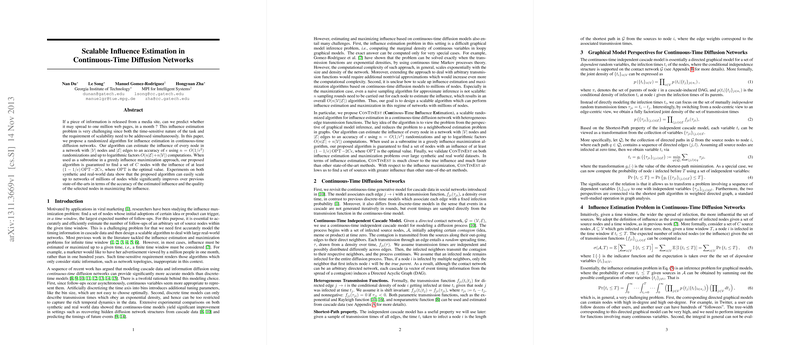Scalable Influence Estimation in Continuous-Time Diffusion Networks: An Expert Overview
In the paper presented, the authors propose a novel approach to address the influence estimation problem in continuous-time diffusion networks, a critical issue relevant to applications in viral marketing and information dissemination. The challenge lies in effectively predicting whether information released from a source could proliferate extensively within a finite temporal window, for example, to one million web pages within a month. This necessitates methodologies that are both temporally sensitive and scalable in handling networks that encompass millions of nodes.
Methodology
The core contribution of the paper is the introduction of ConTinEst, a randomized algorithm designed for influence estimation and maximization in continuous-time diffusion networks. Traditional models primarily focused on discrete-time frameworks, which inadequately represent the asynchronous nature of event follow-ups in real-world networks. The continuous-time model explored in this paper, leveraging heterogeneous transmission functions across network edges, better captures the intricate temporal dynamics of information spread.
ConTinEst stands out by re-framing the influence estimation as a neighborhood estimation problem within graphical models, thus allowing for approximation methods that simplify the computational process significantly. The algorithm estimates the influence of nodes with randomizations—a method that linearly scales with respect to the number of network edges and nodes, specifically $O(n|\Ecal| + n|\Vcal|)$ computations, where $|\Ecal|$ and $|\Vcal|$ denote the number of edges and nodes, respectively.
Theoretical Underpinnings and Experimentation
The algorithm guarantees a result where the selected set of nodes reaches an influence level of at least , with representing the theoretical optimal influence. This result aligns with known guarantees provided by submodular function maximization, an NP-hard problem for which a greedy approach yields a constant-factor approximation.
Experimentally, ConTinEst was evaluated on both synthetic and real-world datasets, showcasing its ability to handle networks with up to millions of nodes efficiently. The results demonstrated substantial improvements over existing state-of-the-art methodologies in both the accuracy of estimated influence and the quality of node selection for maximizing influence. This was verified through comparative analyses with baseline algorithms, exhibiting notable reductions in computational complexity and enhanced scalability.
Implications and Future Directions
The findings presented signify critical advancements in the capability to model information diffusion in a temporally realistic manner. For practical applications, particularly in social media analytics, marketing campaigns, and e-commerce, the ability to accurately estimate and strategically leverage influence in networks opens avenues for refined targeting and resource allocation strategies.
The theoretical implications are equally substantial, contributing valuable insights into continuous-time modeling and approximation techniques within complex networks. The convergence of network science and information theory principles demonstrated here propels further exploration into large-scale, dynamic systems where influence mechanics play a pivotal role.
Future research trajectories may delve into refining these models for other continuous-time settings, such as epidemiological spread in public health domains or financial contagion in economic systems. Moreover, investigating the integration of real-time data assimilation and feedback mechanisms could enhance adaptive influence strategies, aligning the model more closely with dynamic, evolving environments.
In conclusion, the scalable algorithmic framework provided by ConTinEst represents a robust tool for influence analysis within continuous-time diffusion networks, promising to significantly enhance both theoretical understanding and practical applicability in the field of network analysis.
